Author: Author: Joseph L. DORRIS Date: 2014-9-13 20:53:14
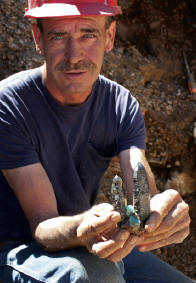
Working in the Lucky Monday pocket, note pegmatite vein. Ch. Borland photo. J. Dorris photo.
Genthelvite
A pocket found adjacent to theLucky Monday pocket held the firstgenthelvite crystals found in the LakeGeorge district. These occurred as loose,lustrous crystals up to 5 cm acrossin blocky, octahedral habit. Color isa dark maroon with reddish halos. Three significant crystals and approximatelya dozen small fragments were recovered.
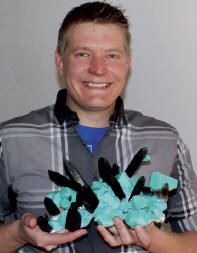
Tim proudly holding “Porcupine” after cleaning was finished. K. Velasco photo.
Goethite
A yellow brown mass of goethite replacinga carbonate, likely calcite, wasfound in the central area of the pocket.
Goethite often forms lustrous, silver tobronze colored, bladed sprays but also frequently replaces carbonate crystals,forming dark brown or black rhombicpsuedomorphs. A one centimeter scalenohedral psuedomorph was found onamazonite matrix. All other goethite wasunremarkable.
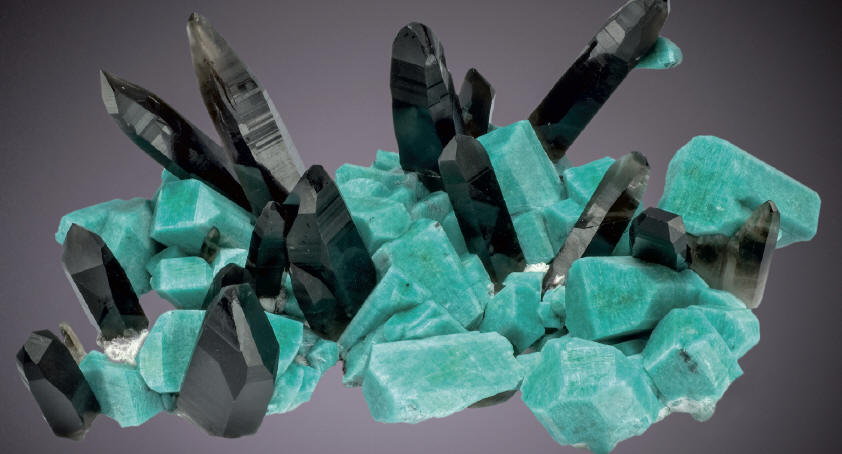
“Porcupine”, 32 cm in length (sic!) is probably the best known specimen of smoky quartz with amazonite from the Crystal Peak area. It was repaired from tens of small pieces carefully collected by Tim. M. Pospisil collection. J. Scovil photo.
Microcline variety amazonite
Although microcline is very commonthroughout the world, the blue green varietyknown as amazonite is recoveredfrom only a few areas. Those from thePikes Peak Batholith exhibit the bestcrystal form and color combination.
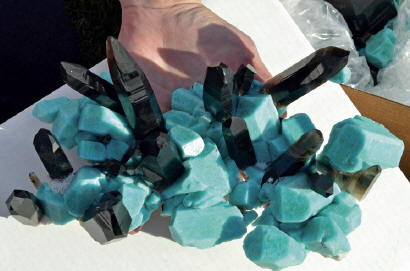
Incredible “Porcupine” photograped in Tucson 2013. J. Gajowniczek photo.
Color is attributed to a small amount oflead ion in conjunction with structuralwater in the presence of ionizing radiation.
If the amounts vary too greatly orinsufficiently, the color is not as rich.
Some evidence also suggests the slowercrystallizing pockets with longer radiationexposure are more likely to containbetter color as compared with the morerapidly crystallizing pockets. Additionally,microcline with a light body colorsuch as white, as compared to dark buffor gray, also gives rise to more vividlycolored amazonite. For unknown reasons,the conditions at the Smoky Hawkwere ideal and the majority of pocketscontain richly colored amazonite.
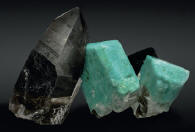
10 cm specimen from the pocket. Pinnacle 5 Minerals specimen. J. Callén photo.
Amazonite colors vary from pale todeep robin-egg blue. Hue and saturationrange from gray muddy colors to bright,vivid colors. Until recently, the vast majorityof amazonite crystals from theCrystal Peak district were known fortheir medium blue-green color, largely ofmottled colors of gray green to brownishgreen, commonly with white splotches.
Uniformly colored amazonite is very rareand is indicative of a slightly higher crystallizationtemperature. When the temperaturedrops, colorless albiteexsolution forms, creating a white mottlingknown as perthite. The deep, uniformcolors are so rare, many people find it difficult to believe they are natural.
A few noteworthy pockets foundthroughout the history of the region, andthe recent discoveries of vivid-coloredamazonite crystals on the Smoky Hawkstructure, are helping correct this perception.
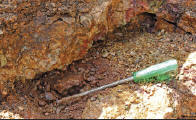
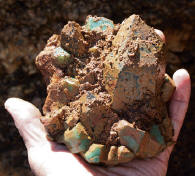
Same specimen still in situ in the pocket (upside down above screwdriver termination)
and in hand. Ch. Borland photo.
The Lucky Monday pocket producedwell-formed and sharply terminatedamazonite crystals averaging 2.5 cm butreaching 6 cm, occurring mostly indruses with smoky quartz crystals.
Notwinned crystals were found. None displayedany white stripes or caps but theyall displayed a bright, uniform blue green color. Exceptional luster is exhibited onthe crystal domes and to a lesser extent,on the prism sides. Fortunately, only relativelyminor Fe-Mn oxides and clayovergrowths were present and were easilyremoved during cleaning resulting inexceptional amazonite crystals.









 YueGongAnBei 44051102000467
YueGongAnBei 44051102000467


 |
|